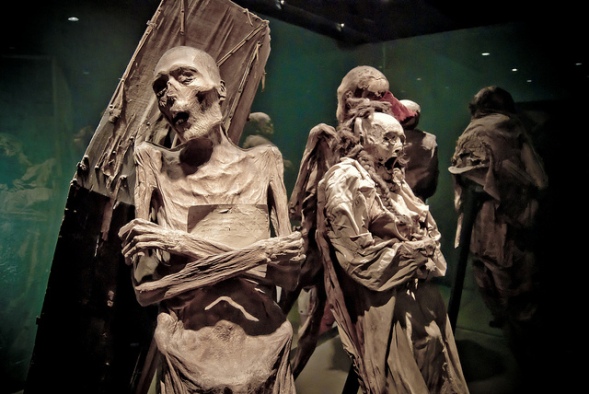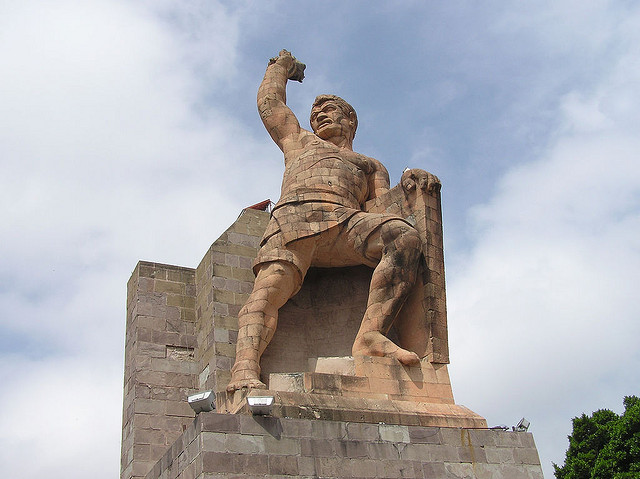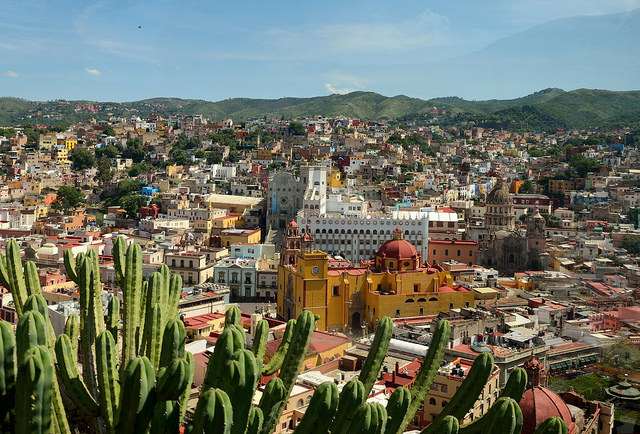Subterranean secrets below and Spanish colonial grandeur above ground make Guanajuato one of Mexico’s most endearing and fascinating places to explore.

Mummies look on as people wander through the Mummy Museum. (Photo: A. Castro via Flickr)
Javier paused to breathe. There were only five steps left, but at 82 years old, the previous 500 had sapped most of his energy. Oxygen at 2000m is scarce. In front of him loomed the salmon-coloured statue of the mining town’s hero, El Pípila. He raised his head, tensed his muscles and pushed on to the top. El Pípila was looking out at something, and Javier turned to see what it was. The old mining town of Guanajuato spread out below, like multi-coloured polystyrene pieces spilled over a boot-print left in soft clay.
I had been trying to write a little, but there was too much life and beauty in front of me. The writing could wait. I struck up a conversation with Javier, who had spent some time looking out over the town that bore deep resemblance still to that of when he was a boy, unlike Mexico City. The land before us was one of porous rock, hiding the secrets of history and time, both geological and anthropological. Javier told me he enjoyed discovering something new upon every visit.
The Spanish Empire had done too. It had grown fat and wealthy from the proceeds of Mexico’s innards. By the end of the 18th century, more silver had been exhumed and exported from Guanajuato than anywhere else on the planet. Naturally, this made the city one of the wealthiest in the Spanish empire, but resentment often grows among those who feel robbed. The Spanish tenure had an expiry date.
For Javier there is nothing but contentment. He told me how he studied engineering at the university in this town six decades ago, before moving back to Mexico City after graduation. The journey out to Guanajuato is one he undertakes every year. Not only is the air more salubrious, but he welcomes the exercise. Mexico City is not the most pedestrian-friendly city. It has the worst air pollution in the western hemisphere. Javier gulped in the crisp, cool mountain air and leaned on the statue, cut from local cantera stone.
Digging down and rising up
El Pípila became the town’s hero during the fight for Mexican independence. A war that spanned over a decade before the Spanish were vanquished, it inspired others across the country – and even the continent – to grapple for freedom from the European yoke. Many of the earliest battles of the Mexican war of independence took place in these mining towns.
On September 28th 1810, El Pípila was instrumental in the massacre of Spanish troops and Spanish civilians who had taken refuge in a grain warehouse. It was less than two weeks since Miguel Hidalgo had started the uprising 130km away in Queretaro – an opal mining region.

El Pipila still has a commanding presence over the city. (Photo: H.Bennetsen via Flickr)
By tying a flat stone to his back to act as a shield from the gunfire of the Spanish soldiers, El Pípila advanced on the warehouse with a flask of tar and a torch. He burned down the barricaded warehouse door, and a rabble of Mexican miners took care of the rest. Guanajuato was not truly free until 1821. It was a significant, yet bloody start.
Today there are just a few mines left in operation. Some of the old stalwart mines, such as the famous La Valenciana mine, where ground was broken in 1760, have ceased operations but provide tours. At its peak La Valenciana produced more than half of the world’s silver. I follow as Javier wanders up to the colonial façade. He admits he can no longer negotiate the precarious steps inside, but the mine still means something to him. He tells me that the first jewellery he bought for his late wife was made of silver mined here. I wonder how many other men all over the world declared their love with the products of this hole in the Mexican ground.
Javier was content to wander through the pretty grounds and the nearby church, while I took a plunge into the colonial caverns, cut claustrophobically close. Everything seemed precarious with gravity pulling at the kilometre of rock above my head.
A walk on the mild side
Buildings along the tight streets of the centre almost seemed to converge above me. At times, it felt as though Javier and I were completely surrounded by stone. The old streets gave the impression that the town was designed to replicate the feeling of being down in the mines. But looking up, we could always see the clear, blue sky.
Here and there, old Spanish Baroque buildings decorate the edge of plazas filled with people. Constructed in 1796, the Alhondiga de Granaditas is a sturdy grey structure with only the smallest holes for windows. This no frills building may seem rather insipid, but it is the very grain warehouse in which the Spanish had sought refuge in 1810. Even now it looks impregnable, but there is a museum open to the public, so there is no need for tar and a naked flame to get inside.
We walked the short distance – downhill all the way – to the Jardin de la Union, a shaded plaza marking the centre of town. A student was selling charcoal drawings to a tourist over by the Juarez Theatre. The beautifully preserved neo-classical building commanded the attention of the plaza.
We rested under one of the fig trees that had their foliage pruned into perfect dense cubes, like slabs of quarried green stone. The dense canopy of the ficus shielded us from the early afternoon sun and Javier removed his faded red baseball cap to draw a forearm across his perspiring brow. The bases of the tree trunks were painted in thick white lime paint to prevent the bark becoming weakened and susceptible to invasive insects.
We watched children buy ice creams from a man with a trolley. Tourists posed by the theatre pulling silly faces. Two suited men with guitar cases ascended the steps of the theatre to prepare for the night’s performance.
Inside, the theatre is beautifully designed and decorated in the original style in which it was conceived in 1903. Elaborate carving and painting in warm colours creates a sense of ease and comfort, before being blotted out as the lights fall and the proscenium arch gains prominence. We had seats up in the Gods and looked down at the 20 men gathered on stage with guitars, one man with a double bass and three vocalists. A Mexican orchestra. A variety of musical acts followed that illustrated the vibrancy and popularity of Mexican folk music. Javier, like most Mexicans in the audience, knew the lyrics to all of the songs.

The multi-coloured polystyrene pieces of Guanajuato scattered below. (Photo: Russ Bowling via Flickr)
Mummy Mia
Mexico’s central highlands are arid and warm. It is thought that this combination of mineral-rich soils, extreme dry weather and warmth created a unique phenomenon in the city’s municipal cemetery.
The Mummies of Guanajuato were discovered after local authorities began charging a burial tax for the municipal cemetery. If families of the interred were unable to pay the tax, then the bodies were exhumed for cremation. Those buried underground were decomposed as was normal. But a peculiar thing had happened to those buried in chambers above ground: they were mummified. None had undergone the embalming process commonly associated with mummification since the Ancient Egyptians.
Javier and I took the bus a little way from the centre of town where I helped him down from the steep bottom step of the bus, before it rattled away on its circular route. We stood before the cemetery gates. Javier was no stranger to cemeteries. The Mexicans have a unique view of death, celebrating what the deceased achieved in life, rather than mourning their loss. The Day of the Dead is a national holiday where most people take a trip to the cemetery to be with their loved ones. A union of the passed and the present.
The mummies were so unique that instead of being cremated, many of them were placed in a museum. Even at his age, Javier was moved by the display. Each in their own glass sarcophagi, the withered features of the dead bear recognisable features. Their final expressions were frozen in time. Many had mouths agape in an expression of fear or surprise. Others grimaced at the looming darkness. One, a woman, had her hands folded serenely at her navel. Perhaps she had been granted the dignity of a peaceful death surrounded by her family. One man screamed silently at eternity, the hole in his chest and deep ruby stain of his blood surrounding it suggesting his end was not a peaceful one. What moved us most were the mummified children. Javier reached out to touch the glass case, thanking God that his own children would outlive him.
Hobbling out into the bright afternoon, legs aching from the exertion of the day, Javier smiled back down at the city, while I wondered what other secrets lay buried there, waiting to be discovered.
Details:
Mina La Valenciana is the one mine that runs regular tours on a daily basis. It is situated 4km north of central Guanajuato and is also known by its full name San Cayetano de Valenciana. The Museo de las Momias is 1km west of the centre.